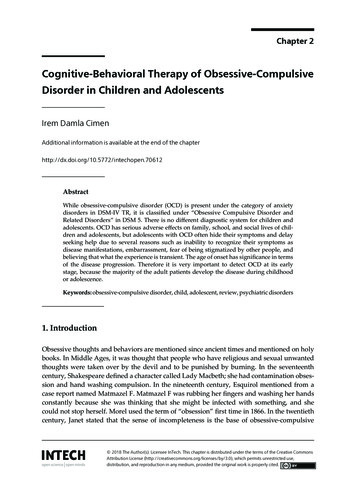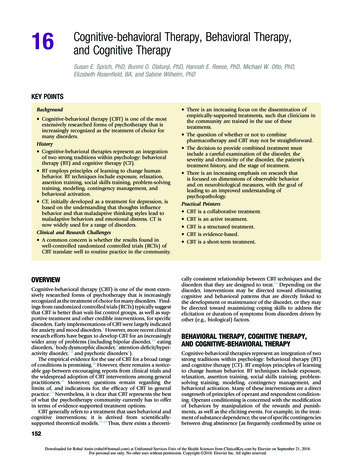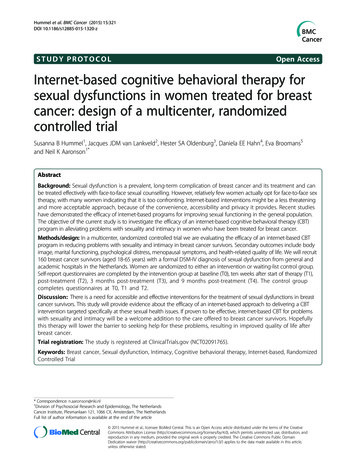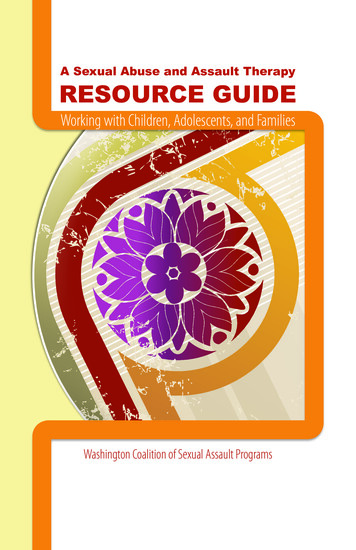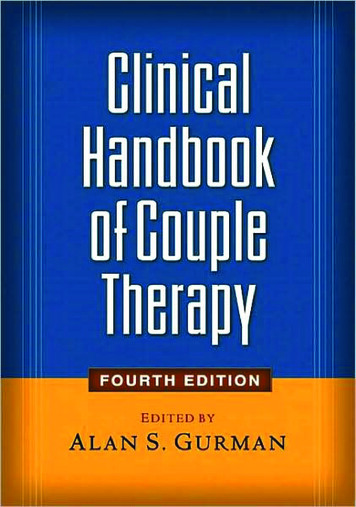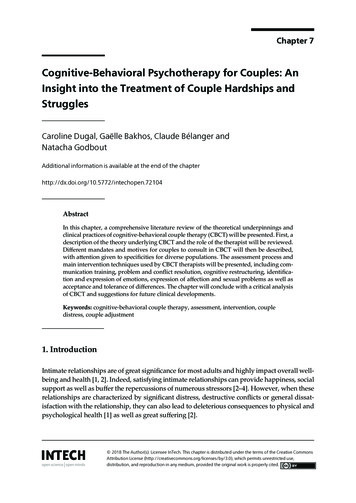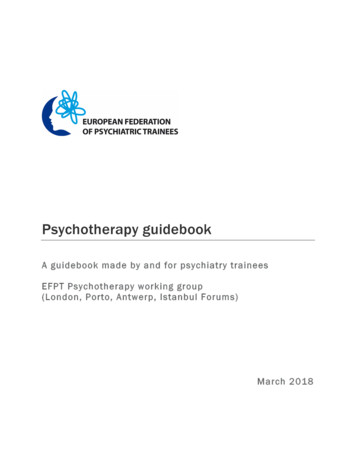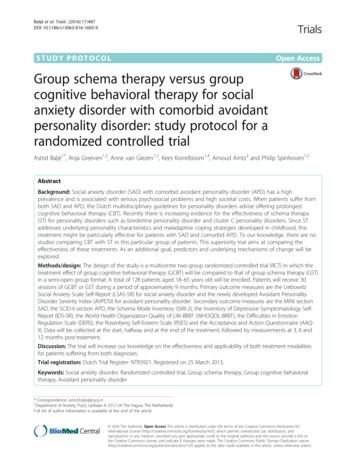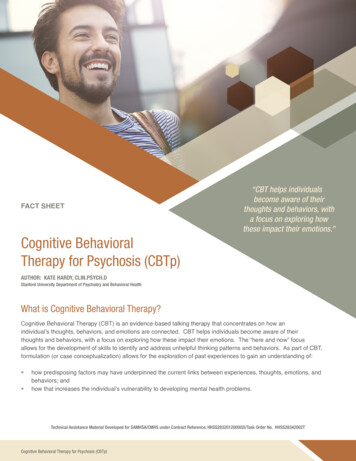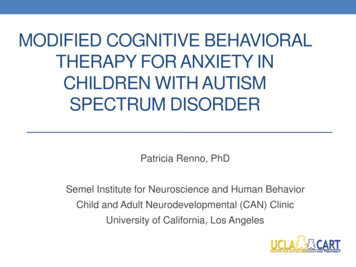
Transcription
MODIFIED COGNITIVE BEHAVIORALTHERAPY FOR ANXIETY INCHILDREN WITH AUTISMSPECTRUM DISORDERPatricia Renno, PhDSemel Institute for Neuroscience and Human BehaviorChild and Adult Neurodevelopmental (CAN) ClinicUniversity of California, Los Angeles
Outline 1. The presentation of anxiety in youth with autism 2. Cognitive behavioral therapy principles to treat anxietyin children with autism 3. Modifications to CBT for childrenwith autism 4. Resources for families andpractitioners
Anxiety versus Anxiety Disorders Anxiety: A mood state of mixednegative emotion and neuralarousal that occurs whenanticipating a future threat. Anormal mood state experienced byeveryone at times. Has adaptive(motivational) value. Anxiety Disorders: Unrealistic,disabling anxiety associated withpersonal distress and substantialimpairment in social, academic, orfamily functioning.
Background Case 1, Donald: “we brought him to aplayground slide when other childrenwere sliding on it he would not geton it he seemed horrorstruck.” Case 2, Barbara: “very timid, fearful ofvarious and changing things, wind,large animals, running water, gasburners, and many other things.” Case 8: Alfred: “ a good deal of ‘worrying.’ He frets when the bread is putin the oven to be made into toast, and is afraid it will get burned and behurt ”
Significance of Anxiety in ASD One of the most common associated psychiatric concerns amongindividuals with ASD. Associated with a number of physical and psychosocial symptoms: Negative effect on school performance, peer relationships, family functioning Exacerbation of core ASD symptoms More problem behavior Gastrointestinal illness Self-injurious behavior Depressive symptoms(e.g., Evans et al., 2005; Reaven, 2009; Wood & Gadow, 2010;de Bruin et al., 2006; (van Steensel, Dirksen, & Bögels, 2013)
Prevalence of Anxiety in Youth
Separation Anxiety Disorder Occurs in up to 9% of youth with autism Distress when separating fromloved ones Worry about harm or loss ofloved one Worry of an event that would causeseparation from loved one Reluctance to go out Nightmares, co-sleeping, resistantto being aloneVan Steensel, Bogels, & Perrin (2011)[Meta-analysis]
Social Anxiety Disorder Occurs in up to 17% of youth with autism Fear of being negativelyevaluated by others Avoid social situations May cry, throw a tempertantrum, freeze-up, fail tospeakVan Steensel, Bogels, & Perrin (2011)[Meta-analysis]
Generalized Anxiety Disorder Occurs in up to 15% of youth with autism Excessive anxiety and worry thatis difficult to control Worries about school, family,the weather, health, finances Accompanied by physiologicalsymptoms (e.g., muscle tension,sleep disturbance, irritability)Van Steensel, Bogels, & Perrin (2011)[Meta-analysis]
Specific Phobia Occurs in up to 30% of youth with autism Very specific fears Animals Natural environment Shots Doctors Costumed characters Significantly interferes in the child’slifeVan Steensel, Bogels, & Perrin (2011)[Meta-analysis]
Obsessive Compulsive Disorder Occurs in up to 17% of youth with autism Unwanted thoughts and images thatare distressing and cause anxiety anddiscomfort Individual may engage in repetitivebehavior (compulsion) to reduce anxiety Common types: fear of contamination,exactness/symmetry, checking,repeatingVan Steensel, Bogels, & Perrin (2011)[Meta-analysis]
Recent Research on Ambiguous AnxietySymptoms in ASD Atypical Specific Fears E.g., fear of toilets, vacuum cleaners,happy birthday song, bubbles, running water Atypical Social Fear Social fearfulness withoutawareness of social judgmentor negative social evaluation Fear of Change Special Interest Fear Fear around not being ableto access special interest Fears around Sensory Sensitivities(e.g., Kerns & Kendall, 2012)
Presentation of Anxiety Physiological manifestation Increased arousal: “Fight or Flight” Response Pounding heart, sweating, headaches, stomach upset, dizziness, muscletension, shortness of breath, shaking Anxious facial expression and body language Crying/screaming Sleep/eating disturbances Behavioral manifestation Avoidance, escape, reassurance, distraction Cognitive manifestation Cognitive distortions (Catastrophizing,all or nothing thinking) Worrying about perceived threats
What it may also look like in ASD Behavioral manifestation: Increases in: Sensory behaviors Repetitive behaviors Ritualistic behaviors Socially inappropriate behaviors Challenging behaviors Cognitive manifestation: May be no clearly identifiable threatcognitionMagiati et al., 2017
Why so Common in ASD? Brain mechanism/Genetics? Role of the amygdala in both syndromes Herrington et al, 2017 (JADD) Increased rate of mood disorders in parents of children with ASD Common neuro-cognitive mechanisms? Executive functioning deficits Cognitive rigidity Difficulty shifting one’s attention Cognitive “stickiness” Perseverative thinking style Rumination on negative thoughts High levels of daily stress due to ASD?
Assessment of Anxiety in ASDAnxietyASDPeerrelationshipsExcessiveLack of ingTenseLack of pretendplayResistance tochangeImpairment incommunicationPerseverativebehaviorAvoidance ofnoveltySleep*Slide courtesy ofdisturbanceDr. Lindsey Sterling
Assessment of Anxiety in ASD Challenging! Many overlapping symptoms Impaired communication of youth with ASD Impaired insight Ambiguous manifestations of anxiety in ASD Co-occurring intellectual disability
Construct Validity of Anxiety in ASD Symptoms can be reliably differentiated! Emerging evidence of Construct Validity: Convergent and discriminant validity (Renno & Wood, 2013) Elevated baseline skin conductance (Sterling et al., under review) Expected treatment response (Wood et al., 2009) Genetic markers of negative affectivity/anxiety in TD youth are alsopresent in children with ASD and anxiety (Gadow et al., 2014,2008, 2009, 2010)
Treatment of Anxiety in ASD
RCTs conducted at UCLA
Other Studies
Brief Empirical Evidence of Effectivenessof CBT Trial in Children with ASD % Diagnostic Remission @ Post (Wood et al., 2014)% AnxietyDisorderRemission—ADIS
Observed Positive Peer SocialEngagementF (1,10) 8.86, p .05;Cohen’s d Effect Size 1.62
Treatment of Anxiety in ASD:Cognitive Behavioral Therapy (CBT)What we think affectshow we act and feel.ThoughtBehaviorWhat we do affects howwe think and feel.EmotionWhat we feel affects howwe act and think.
Phase One: Psychoeducation What is Anxiety? Brain-based, activation of theamygdala, fight/flight response Learn Bodily cues of anxiety Learn Facial expressions Parents learn common patternsof child anxiety
Phase 2: Skills Training Build Coping Skills Relaxation Identifying irrational/maladaptive thoughts Cognitive Restructuring: replacing catastrophic thoughtswith more rational thoughts Positive “self-talk”
Identifying Negative Thoughts Learning to identify negative thoughts and cognitions thatwe have about different situations. What “bad things” we think are going to happen.If I make a mistakeeveryone is going tolaugh at me andnobody is going towant to be my friend.There is nobodywho wants to bemy friend I don’tfit in and I neverwill.I’m going to failthis test and neverget into college.If my parents leaveme, they are going toget in a car accidentand I’ll never seethem again.
Identifying Calm Thoughts Fighting back against “irrational thoughts” Ex.: What’s the likelihood of it happening? Ex.: If it does happen, how bad is it really going to be?Probably nobodywill even notice. Peoplemake mistakes allthe time.Nobody is perfect.I’m doing the bestthat I can.It’s not very likely they’dget in a car accident.They’ve never been inan accident before.I just haven’t foundthe right friend yet.There are lots ofpeople I haven’t metyet.
Phase 3: Skills Practice Hierarchy of fears with “fear ratings” Break feared situations into “baby steps” Children gradually attempt increasingly “challenging” fearedsituations to develop confidence and mastery. Practice in sessionand throughout the week “What did we teach ourbrain today?” Positive Reinforcementfor hard work!
Case Example
Background about BIACABehavioral Interventions for Anxiety in Children with Autism Family-based Cognitive Behavioral Therapy 16 weekly sessions, 90 minutes each. Modular-based Phase 1: Psychoeducation Phase 2: Skills Training Phase 3: Skills practice (50% of sessions)
Modifications for ASD:Large Scale Reward System Necessary!! Idea: Compensation for hard work Verbal Praise Must be motivating to the child Not socks
Modifications for ASD:Visual Aides Lots of cartoons and visual prompts!
Modifications for ASD:Use of Special Interests
Modifications for ASD:Include Social Communication Goals
Modifications for ASD:Independence and Self-Help Skills Focus
Important Ingredients:Homework
Specialized Parenting Techniques Model staying calm and usingcoping skills Accept and label the emotion Give your child time to cooldown and work through theanxiety on his/her own Provide choices Reward
Limitations to the Evidence-Base Research conducted in the clinic setting Lots of supervision/eyes on the case Highly invested families Need to be tested in schools and the community Research limited to youth with ASD and IQ 70 RCTs so far have excluded children who are minimally verbal andhave IQs 70. Some research has started modifying CBT for use with minimallyverbal youth with ASD and IQ 70 (Dr. John Danial)
Behavioral Interventions for Anxiety inMinimally Verbal Individuals with ASD Graduated exposure plus positive reinforcement Modeling Prompting Visual aides Mantras Examples in the literature: fear of dogs, water, socialactivities, swimming pools, blood drawsHagopian et al., 2017
CBT Resources: Professionals Treatment guide for parents, teachers, and mental healthprofessionals: Managing Anxiety in People with Autism by Anne Chalfant Published manuals for Clinicians: CBT for Children and Adolescents with High-Functioning Autism Spectrum Disorders by AngelaScarpa, Susan White, & Tony Attwood Child Anxiety Disorders: A Family-Based TreatmentManual for Practitioners by Jeffrey J. Wood & Bryce D.Mcleod (for TD) Research Study: Internet-Based CBTtraining for clinicians in the communityworking with children with ASD If interested: contact Dr. Jeffrey Woodjwood@gseis.ucla.edu
Anxiety Resources: Families Published manual for anxiety in people with autism: Managing Anxiety in People With Autism: A Treatment Guide for Parents,Teachers and Mental Health Professionals by Anne M. Chalfant Child Anxiety Tales (Phil Kendall) Online parent training program to help anxious youth(not specific to ASD) Children’s Books Wilma Jean the Worry Machine by Julia CookIs a Worry Worrying You? by Ferida WolffWemberly Worried by Kevin HenkesWhat to Do When You Worry Too Much by Dawn Huebner Teen Books My Anxious Mind: A Teen’s Guide to Managing Anxiety and Panic by MichaelTompkins
Acknowledgements UCLA colleagues:Jeffrey Wood, PhD Karen Sze Wood, PhD Amy Drahota, PhDCori Fujii, PhDKelly Decker, PhDKaycie Deane, PhDJohn Danial, PhDLindsey Sterling, PhD Connor Kerns, PhDSpecial thanks for the time and dedication of the familieswho participated in these studies. Funding Agencies:
Contact information Patricia Renno: prenno@mednet.ucla.eduThank you!
Behavioral Interventions for Anxiety in Children with Autism Family-based Cognitive Behavioral Therapy 16 weekly sessions, 90 minutes each. Modular-based Phase 1: Psychoeducation Phase 2: Skill
